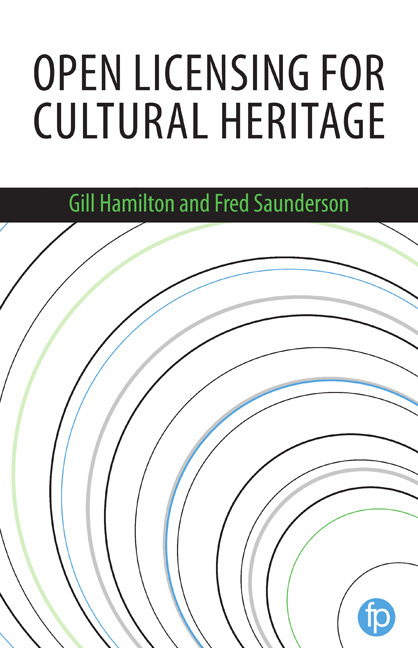Book contents
- Frontmatter
- Contents
- List of figures and tables
- Acknowledgements
- About the authors
- 1 Introduction
- 2 The open movement: its history and development
- 3 Copyright and licensing: a background
- 4 Open licensing: the logical option for cultural heritage
- Introduction to case studies
- 5 Small steps, big impact – how SMK became SMK Open
- 6 The British Library experience of open metadata licensing
- 7 Open policy and collaboration with Wikimedia at the National Library of Wales
- 8 Newcastle Libraries – the public library as a place to share culture
- 9 Developing open licensing at the National Library of Scotland
- 10 The Wellcome Library
- 11 Developing an open educational resources policy and open approaches to mitigate risk at University of Edinburgh
- 12 How to implement open licensing
- 13 Using and reusing openly licensed resources
- 14 Conclusion
- Index
3 - Copyright and licensing: a background
Published online by Cambridge University Press: 08 June 2018
- Frontmatter
- Contents
- List of figures and tables
- Acknowledgements
- About the authors
- 1 Introduction
- 2 The open movement: its history and development
- 3 Copyright and licensing: a background
- 4 Open licensing: the logical option for cultural heritage
- Introduction to case studies
- 5 Small steps, big impact – how SMK became SMK Open
- 6 The British Library experience of open metadata licensing
- 7 Open policy and collaboration with Wikimedia at the National Library of Wales
- 8 Newcastle Libraries – the public library as a place to share culture
- 9 Developing open licensing at the National Library of Scotland
- 10 The Wellcome Library
- 11 Developing an open educational resources policy and open approaches to mitigate risk at University of Edinburgh
- 12 How to implement open licensing
- 13 Using and reusing openly licensed resources
- 14 Conclusion
- Index
Summary
Introduction
This chapter provides an overview of copyright and other intellectual property rights, giving background and context to the development of intellectual property licensing, openness and the open movement. After describing rights such as those afforded by patents and trademarks, the chapter focuses on copyright and how original creative works are intellectually protected in the UK, Europe and internationally. A key section of the chapter addresses the ‘threshold of originality’, which can be of critical importance to cultural organisations engaged in digitisation work. Finally, the chapter describes the components and purposes of licensing and open licences and gives context to the concept of the public domain and the expiration of copyright.
Intellectual property rights
Licensing, openness and the open movement outlined in the preceding chapter partly arise as a reaction to the presence of intellectual property rights. These are a collection of associated property rights, which each afford protection to a particular aspect of intellectual creation. In the UK there are five intellectual property rights: patents, trademarks, registered designs, design right and copy - right. The first three of these rights are registered rights. Such rights do not arise naturally, and only afford protection following a successful application and registration process. The latter two rights, design right and copyright, are automatic rights, which arise naturally and do not need to be registered.
Patents
Patents provide protection for inventions and innovations. There is a particularly long tradition of patenting in the UK, with the first recorded English patent being granted in 1449. This grant provided John of Utynam, who had devised a novel glass-producing technique, a 20-year monopoly on the right to exploit his invention in England. Because the purpose of a patent is to grant a monopoly exploitation right to an inventor of something new, which has advanced the current state-of-the-art, registration places a heavy emphasis on the demonstra - tion of innovation and applicability.
Today patent registration authorities, such as the UK Intellectual Property Office, publish patent applications and grants online. This makes patenting something of a dichotomous activity. On the one hand, seeking a patent exposes an invention in minute detail. On the other hand, once registered, for a period of time, the patent holder enjoys the sole right to benefit from that invention.
- Type
- Chapter
- Information
- Open Licensing for Cultural Heritage , pp. 31 - 64Publisher: FacetPrint publication year: 2017



